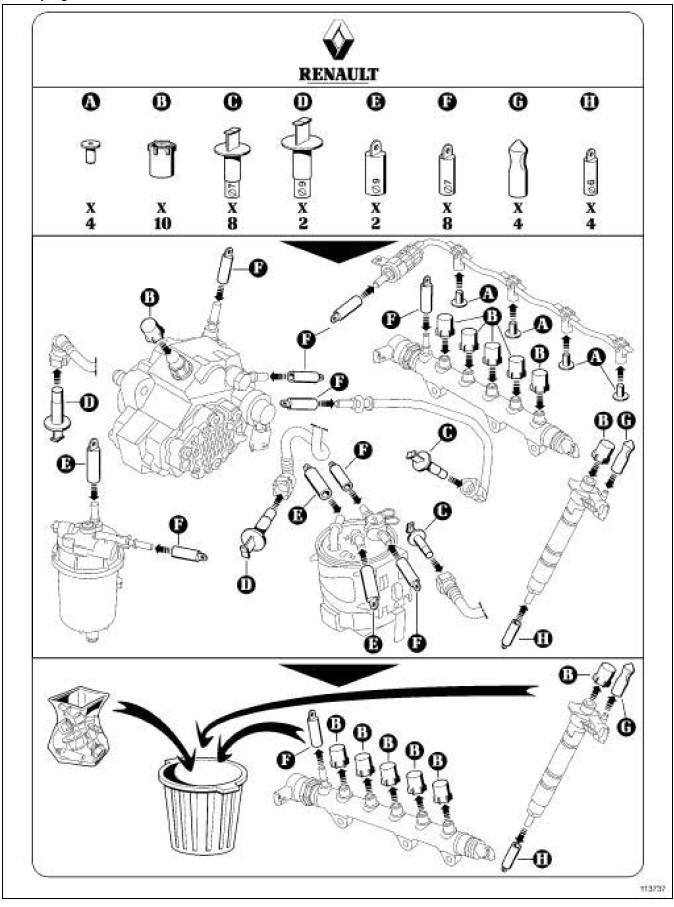Renault Koleos Service Repair Manual: Diesel injection: Precautions for the repair
M9R I - RISKS RELATING TO CONTAMINATION The high-pressure direct injection system is highly sensitive to contamination. The risks caused by contamination are:
All After-Sales operations must be performed under very clean conditions. Having carried out an operation in good conditions means that no impurities (particles a few microns in size) have penetrated the system during dismantling. The cleanliness principle must be applied from the filter to the injectors. What are the sources of contamination?
1 - Cleaning cloths Use lint-free cleaning cloths. It is prohibited to use cloths or ordinary paper towels: these produce lint and lose fibres, which then contaminate the fuel circuit. Each cloth must only be used once. 2 - Blanking plugs The blanking plugs are used to cap the fuel circuit once it is opened and to therefore prevent contaminants from entering. A set of blanking plugs should be used once only and used plugs must be discarded after use: once used, the plugs are soiled and cleaning them is not sufficient to make them reusable. Unused plugs must also be discarded and must not be used when carrying out work on an injection system.
3 - Protective bags Use hermetically-resealable plastic bags, using adhesive tape, for example, to store components which will be refitted and reused. Stored parts will therefore be less subject to the risk of contamination. These are single-use bags: after use they must be discarded. 4 - Cleaning products Two cleaning products can be used:
To use the injector cleaner, be sure to have a clean brush in good condition (the brush must not lose any bristles) as well as a clean container which has no impurities in it.
II - ADVICE TO BE FOLLOWED BEFORE ANY OPERATION 1) Carry out the work in a clean working area and take care to protect removed components from dust using plastic bags which are hermetically-resealable, for example. 2) Always order the following from the Parts Department before carrying out work:
3) Wear safety goggles fitted with side shields to prevent the cleaning product from splashing the eyes. 4) Wear leaktight protective gloves (Nitrile type) to avoid prolonged contact with the skin.
5) Before carrying out work on the injection system, use plastic bags or clean rags, for example, to protect:
III - INSTRUCTIONS TO BE FOLLOWED DURING THE OPERATION Wash your hands before and while carrying out the work. Replace leaktight protective gloves (Nitrile type) when they are soiled or damaged. All components removed from the injection system must be stored in a hermetically sealed plastic bag once they have been capped. Reseal the bag hermetically, for example using adhesive tape, even if the bag must be opened shortly afterwards: ambient air can be a source of impurities. After opening the fuel circuit, the use of brushes, cleaning agents, air blow guns, rifle-type brushes or standard cloths is strictly prohibited: these items are likely to allow impurities to enter the system. When replacing a component with a new one or when refitting it after storing it in a plastic bag, do not unpack it until it is time to fit it on the vehicle. IV - CLEANING There are currently two procedures for cleaning the fuel circuit before opening it in order to carry out work in the workshop. These procedures enable the fuel circuit to be cleaned to prevent contamination from entering: they both have the same end result and neither is preferred over the other. 1 - Cleaning using injector cleaner Clear the access to the unions that need opening, following the work procedures specific to the vehicle (see the relevant Workshop Repair Manual). Protect sections which are sensitive to fuel leaks. Pour the injector cleaning agent into a container which is free from impurities.
Dip a clean brush, which is not shedding bristles, into the container of injector cleaning agent.
Clean the unions carefully using the brush and the injector cleaning agent. Blast the components that have been cleaned with compressed air (tools, workbench, and also parts, unions and around the injection system). Check that no bristles from the brush have come away and that the area is clean. Wipe the sections that were cleaned with fresh cleaning cloths. Open the circuit at the unions and immediately fit the relevant blanking plugs.
2 - Using the brake cleaner Clear the access to the unions that need opening, following the work procedures specific to the vehicle . Protect sections which are sensitive to fuel leaks.
Spray the brake cleaner onto the unions to be opened. Clean the unions carefully using fresh cleaning cloths. Blast the components that have been cleaned with compressed air (tools, workbench, and also parts, unions and around the injection system). Check that no bristles from the brush have come away and that the area is clean. Open the circuit at the unions and immediately fit the relevant blanking plugs.
Set of plugs:
|
See More:
Renault Koleos Owners Manual > Getting to know your vehicle: Side protection devices
Side Airbags An airbag can be fitted to each front seat, which are deployed on the side of the seat (door side) to protect the occupants in the case of a severe side impact. Curtain Airbags These are airbag fitted along the sides of the vehicle in the ceiling which trigger along the front and rear d ...
Renault Koleos Owners Manual
- Getting to know your vehicle
- Driving
- Your comfort
- Maintenance
- Practical advice
- Technical specifications



